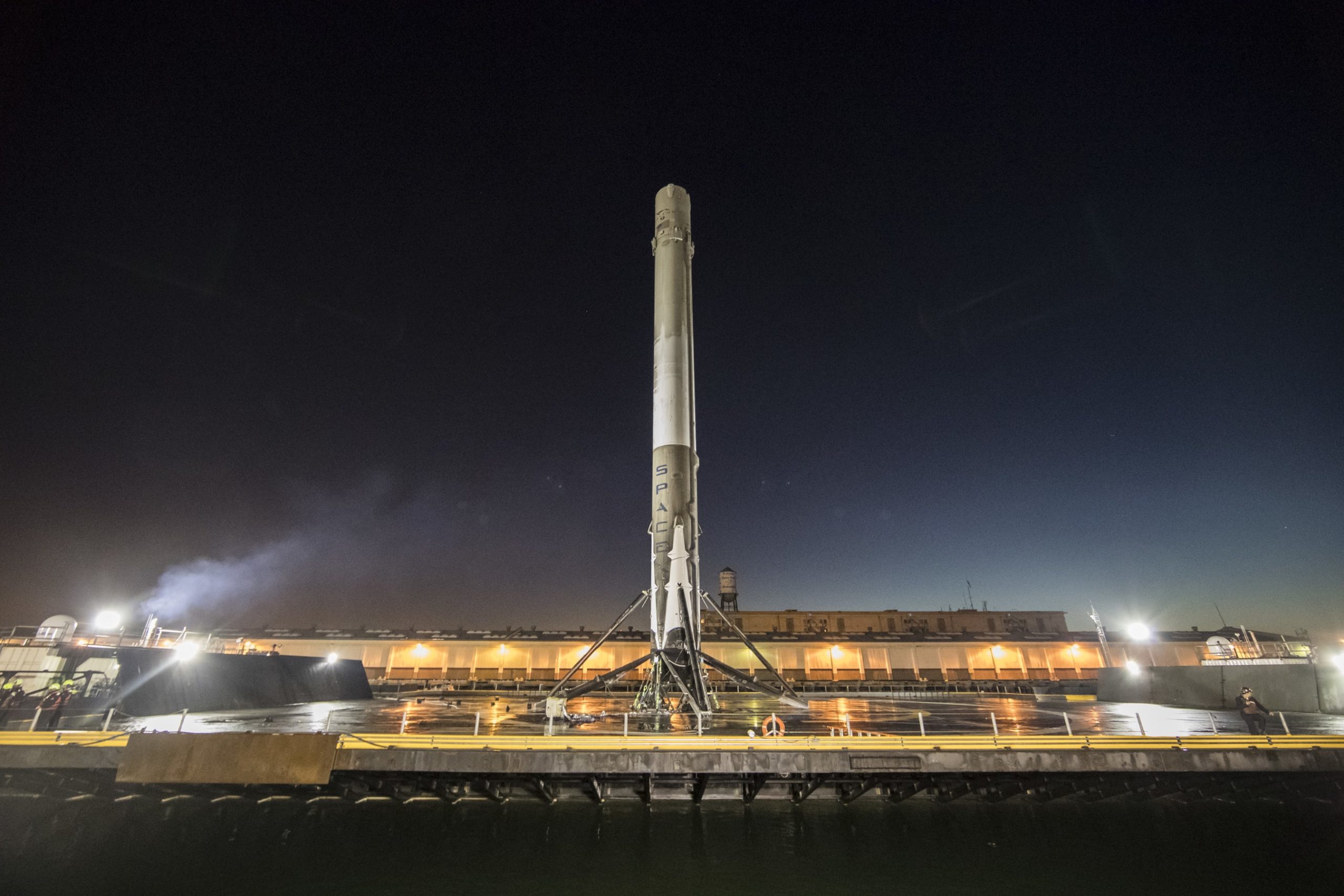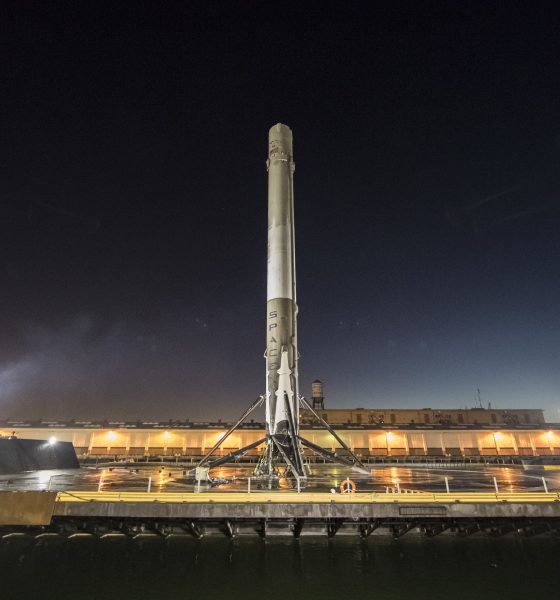

News
SpaceX to kick off October with two launches and landings in 48 hours
SES-11 to be the last launch from LC-39A ahead of pad modifications for Falcon Heavy
After successfully weathering Hurricane Irma, SpaceX is preparing to remedy a slow month with three or even four launches in October.
Beginning on October 2nd, schedules have firmed up for the launch of SES-11 aboard a refurbished Falcon 9 first stage. SES, a Luxembourg-based satellite communications company, took the courageous and pioneering step of purchasing the first reused Falcon 9 for a commercial launch, culminating in the successful SES-10 mission in March 2017. Following that successful first reuse, SpaceX would later launch Bulgariasat-1 aboard a similarly-refurbished booster. SES-11 will become the third commercial reuse of an orbital rocket when it launches early next month from SpaceX’s LC-39A launch pad, and is currently expected to attempt a landing on a drone ship in the Atlantic Ocean.
All 10 Iridium NEXT satellites for the third launch are onsite at Vandenberg. Launching on a Falcon 9, October 4, 6:06am PDT (1:06pm UTC). pic.twitter.com/xBSWpYOx32
— NSF – NASASpaceflight.com (@NASASpaceflight) September 20, 2017
If all goes as planned, SpaceX will launch a second Falcon 9 as few as 36 hours after the SES-11 mission, this time carrying the third batch of 10 Iridium NEXT satellites from Vandenberg Air Force Base, California. All ten satellites have arrived at SpaceX’s VAFB facilities and will be attached to the payload dispenser and later encapsulated inside Falcon 9’s payload fairing over the next two weeks. The Iridium-3 launch will also see the Falcon 9 first stage land aboard SpaceX’s second drone ship, and is bound to be reminiscent of the two back-to-back launches SpaceX conducted on both coasts earlier this summer.

Iridum NEXT satellites being attached to the payload dispenser at SpaceX’s VAFB facilities. (Iridium)
Meanwhile, SpaceX has received an FCC license for first stage recovery activities beginning on October 14th, which meshes well with a scheduled launch date for KoreaSat-5, also 10/14. This date is dependent upon a number of variables that are currently hard to account for, and may slip further into October due to work expected to begin at the LC-39A pad after the launch of SES-11. Confirmed by Chris Bergin of NASASpaceflight.com, SpaceX is planning for SES-11 to be the last mission from the venerable launch pad for several weeks at a minimum, likely closer to several months.
10 days (Sept. 29) to SpaceX Falcon 9 (SES-11) Static Fire…at 39A. Oct. 2 launch, then all hands on deck to prep 39A TEL for Falcon Heavy. pic.twitter.com/B2zxLILqkU
— NSF – NASASpaceflight.com (@NASASpaceflight) September 19, 2017
This downtime is meant to begin at the same time LC-40, SpaceX’s second East coast pad, is reactivated for Falcon 9 launches. In the best-case scenario, this will allow the company to continue business as usual as it modifies LC-39A for Falcon Heavy, which is expected to begin on-pad testing later this year and potentially conduct an inaugural launch as early as November. As such, KoreaSat-5’s Falcon 9 may end up being the pathfinder SpaceX uses to solve the problems and squash the bugs that will inevitably arise while activating a new launch pad. Delays ought to be expected.
Following KoreaSat-5, the next SpaceX launch is not yet clear but will likely be Iridium-4, NEXT satellites 31-40. Including the three launches discussed above, SpaceX is likely to conduct 7-8 more launches before the end of 2017, not counting Falcon Heavy’s inaugural launch due to uncertainty.

Elon Musk
Elon Musk’s X will start using a Tesla-like software update strategy
The initiative seems designed to accelerate updates to the social media platform, while maintaining maximum transparency.

Elon Musk’s social media platform X will adopt a Tesla-esque approach to software updates for its algorithm.
The initiative seems designed to accelerate updates to the social media platform, while maintaining maximum transparency.
X’s updates to its updates
As per Musk in a post on X, the social media company will be making a new algorithm to determine what organic and advertising posts are recommended to users. These updates would then be repeated every four weeks.
“We will make the new 𝕏 algorithm, including all code used to determine what organic and advertising posts are recommended to users, open source in 7 days. This will be repeated every 4 weeks, with comprehensive developer notes, to help you understand what changed,” Musk wrote in his post.
The initiative somewhat mirrors Tesla’s over-the-air update model, where vehicle software is regularly refined and pushed to users with detailed release notes. This should allow users to better understand the details of X’s every update and foster a healthy feedback loop for the social media platform.
xAI and X
X, formerly Twitter, has been acquired by Elon Musk’s artificial intelligence startup, xAI last year. Since then, xAI has seen a rapid rise in valuation. Following the company’s the company’s upsized $20 billion Series E funding round, estimates now suggest that xAI is worth tens about $230 to $235 billion. That’s several times larger than Tesla when Elon Musk received his controversial 2018 CEO Performance Award.
As per xAI, the Series E funding round attracted a diverse group of investors, including Valor Equity Partners, Stepstone Group, Fidelity Management & Research Company, Qatar Investment Authority, MGX, and Baron Capital Group, among others. Strategic partners NVIDIA and Cisco Investments also continued support for building the world’s largest GPU clusters.
News
Tesla FSD Supervised wins MotorTrend’s Best Driver Assistance Award
The decision marks a notable reversal for the publication from prior years, with judges citing major real-world improvements that pushed Tesla’s latest FSD software ahead of every competing ADAS system.

Tesla’s Full Self-Driving (Supervised) system has been named the best driver-assistance technology on the market, earning top honors at the 2026 MotorTrend Best Tech Awards.
The decision marks a notable reversal for the publication from prior years, with judges citing major real-world improvements that pushed Tesla’s latest FSD software ahead of every competing ADAS system. And it wasn’t even close.
MotorTrend reverses course
MotorTrend awarded Tesla FSD (Supervised) its 2026 Best Tech Driver Assistance title after extensive testing of the latest v14 software. The publication acknowledged that it had previously criticized earlier versions of FSD for erratic behavior and near-miss incidents, ultimately favoring rivals such as GM’s Super Cruise in earlier evaluations.
According to MotorTrend, the newest iteration of FSD resolved many of those shortcomings. Testers said v14 showed far smoother behavior in complex urban scenarios, including unprotected left turns, traffic circles, emergency vehicles, and dense city streets. While the system still requires constant driver supervision, judges concluded that no other advanced driver-assistance system currently matches its breadth of capability.
Unlike rival systems that rely on combinations of cameras, radar, lidar, and mapped highways, Tesla’s FSD operates using a camera-only approach and is capable of driving on city streets, rural roads, and freeways. MotorTrend stated that pure utility, the ability to handle nearly all road types, ultimately separated FSD from competitors like Ford BlueCruise, GM Super Cruise, and BMW’s Highway Assistant.
High cost and high capability
MotorTrend also addressed FSD’s pricing, which remains significantly higher than rival systems. Tesla currently charges $8,000 for a one-time purchase or $99 per month for a subscription, compared with far lower upfront and subscription costs from other automakers. The publication noted that the premium is justified given FSD’s unmatched scope and continuous software evolution.
Safety remained a central focus of the evaluation. While testers reported collision-free operation over thousands of miles, they noted ongoing concerns around FSD’s configurable driving modes, including options that allow aggressive driving and speeds beyond posted limits. MotorTrend emphasized that, like all Level 2 systems, FSD still depends on a fully attentive human driver at all times.
Despite those caveats, the publication concluded that Tesla’s rapid software progress fundamentally reshaped the competitive landscape. For drivers seeking the most capable hands-on driver-assistance system available today, MotorTrend concluded Tesla FSD (Supervised) now stands alone at the top.
News
Elon Musk’s Grokipedia surges to 5.6M articles, almost 79% of English Wikipedia
The explosive growth marks a major milestone for the AI-powered online encyclopedia, which was launched by Elon Musk’s xAI just months ago.

Elon Musk’s Grokipedia has grown to an impressive 5,615,201 articles as of today, closing in on 79% of the English Wikipedia’s current total of 7,119,376 articles.
The explosive growth marks a major milestone for the AI-powered online encyclopedia, which was launched by Elon Musk’s xAI just months ago. Needless to say, it would only be a matter of time before Grokipedia exceeds English Wikipedia in sheer volume.
Grokipedia’s rapid growth
xAI’s vision for Grokipedia emphasizes neutrality, while Grok’s reasoning capabilities allow for fast drafting and fact-checking. When Elon Musk announced the initiative in late September 2025, he noted that Grokipedia would be an improvement to Wikipedia because it would be designed to avoid bias.
At the time, Musk noted that Grokipedia “is a necessary step towards the xAI goal of understanding the Universe.”
Grokipedia was launched in late October, and while xAI was careful to list it only as Version 0.1 at the time, the online encyclopedia immediately earned praise. Wikipedia co-founder Larry Sanger highlighted the project’s innovative approach, noting how it leverages AI to fill knowledge gaps and enable rapid updates. Netizens also observed how Grokipedia tends to present articles in a more objective manner compared to Wikipedia, which is edited by humans.
Elon Musk’s ambitious plans
With 5,615,201 total articles, Grokipedia has now grown to almost 79% of English Wikipedia’s article base. This is incredibly quick, though Grokipedia remains text-only for now. xAI, for its part, has now updated the online encyclopedia’s iteration to v0.2.
Elon Musk has shared bold ideas for Grokipedia, including sending a record of the entire knowledge base to space as part of xAI’s mission to preserve and expand human understanding. At some point, Musk stated that Grokipedia will be renamed to Encyclopedia Galactica, and it will be sent to the cosmos.
“When Grokipedia is good enough (long way to go), we will change the name to Encyclopedia Galactica. It will be an open source distillation of all knowledge, including audio, images and video. Join xAI to help build the sci-fi version of the Library of Alexandria!” Musk wrote, adding in a later post that “Copies will be etched in stone and sent to the Moon, Mars and beyond. This time, it will not be lost.”








